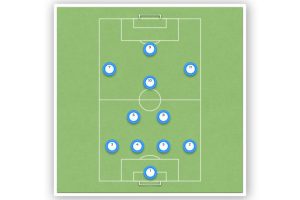Deep-lying Playmaker vs. Regista: Understanding the Key Differences with Expert Analysis and Tables
As a football enthusiast, I have often wondered about the difference between a deep-lying playmaker and a regista. Both positions seem to have similar roles on the pitch, but there must be some differences that set them apart. In this article, I will explore the nuances of these two positions and highlight the key differences between them.
At first glance, both the deep-lying playmaker and the regista seem to be central midfielders who are responsible for controlling the tempo of the game and distributing the ball to their teammates. However, upon closer inspection, there are some key differences that set these two positions apart. For example, the deep-lying playmaker is known for fulfilling extra defensive responsibilities by holding position in front of the defence and rarely looking to support attacks. On the other hand, the regista is a more aggressive version of the deep-lying playmaker, suitable for possession-orientated systems that press high up the pitch.
Defining the Roles
Deep-lying Playmaker
A Deep-lying Playmaker (DLP) is a central midfielder who operates in front of the defense and is responsible for controlling the tempo of the game through their passing. The DLP is a creative player who looks to get on the ball as often as possible and provide the link between defense and attack. They are not tasked with defensive responsibilities, but rather focus on creating chances for the team.
The DLP is also known as the quarterback of the team, as they are responsible for initiating the team’s attacking moves. They are excellent passers of the ball and have a great vision of the game, which allows them to pick out passes that others might not see.
The DLP is a key player in any team that wants to control possession and dominate the midfield. They are often used in a 4-3-3 or a 4-2-3-1 formation, where they can operate in a central position and have the freedom to dictate the game.
Regista
A Regista is a deep-lying playmaker who operates in a central position and is responsible for setting the tempo of the match from build-up to progression, all the way to creation. The Regista is a creative player who looks to get on the ball as often as possible and provide the link between defense and attack. They are not tasked with defensive responsibilities, but rather focus on creating chances for the team.
The Regista is known for their excellent passing ability and vision of the game, which allows them to pick out passes that others might not see. They are often used in a 4-3-3 or a 4-2-3-1 formation, where they can operate in a central position and have the freedom to dictate the game.
The Regista is a key player in any team that wants to control possession and dominate the midfield. They are often compared to the quarterback of the team, as they are responsible for initiating the team’s attacking moves.
Overall, both the DLP and Regista are creative players who are responsible for controlling the tempo of the game through their passing. They are not tasked with defensive responsibilities, but rather focus on creating chances for the team. The main difference between the two roles is that the Regista is known for their ability to set the tempo of the match from build-up to progression, all the way to creation, while the DLP is known for their ability to provide the link between defense and attack.
Key Differences
Playing Style
| Deep-Lying Playmaker | Regista | |
|---|---|---|
| Passes | Short and accurate | Risky |
| Emphasis | Control tempo | Create opportunities |
| Style | Safe and reliable | Aggressive and daring |
| Suitable for | Possession-oriented systems | High pressing systems |
As a deep-lying playmaker, I am responsible for distributing the ball from a deeper position, often acting as a pivot between the defense and midfield. I tend to play shorter, more accurate passes, which allows me to control the tempo of the game and keep possession. In contrast, the regista is a more aggressive version of the deep-lying playmaker, suitable for possession-oriented systems that press high up the pitch. They tend to play riskier passes, with more emphasis on long balls, through balls, and diagonal passes to create opportunities for the forwards.
Positioning
| Deep-Lying Playmaker | Regista | |
|---|---|---|
| Location | In front of defense | Flexible |
| Purpose | Link defense and midfield | Support forwards |
| Opportunities | Receive and distribute ball | Create more opportunities for passes |
The deep-lying playmaker usually operates in a central position, sitting just in front of the defense. They are responsible for linking the defense and midfield, and their positioning allows them to receive the ball from the defenders and distribute it to the midfielders. The regista, on the other hand, is more flexible in their positioning. They tend to push up higher up the pitch, often alongside the attacking midfielders, to create more opportunities for passes and to support the forwards.
Defensive Duties
| Deep-Lying Playmaker | Regista | |
|---|---|---|
| Defensive roles | Intercept passes, tackle, and win back possession | Fewer defensive duties |
| Strategy | Read the game and anticipate opposition’s moves | Rely on positioning to break up opposition attacks |
As a deep-lying playmaker, my primary role is to distribute the ball, but I also have some defensive responsibilities. I need to be able to read the game, anticipate the opposition’s moves, and intercept passes. I also need to be able to tackle and win back possession if necessary. The regista, however, has fewer defensive duties. They are not expected to tackle or intercept as much as the deep-lying playmaker. Instead, they rely on their positioning and ability to read the game to break up opposition attacks.
Offensive Duties
| Deep-Lying Playmaker | Regista | |
|---|---|---|
| Responsibilities | Start attacks, create chances, and keep possession | More creative and adventurous passing to create chances |
| Key passes | Short, incisive passes | Through balls, diagonal passes, and long balls |
Both the deep-lying playmaker and the regista have important offensive duties. As a deep-lying playmaker, I am responsible for starting attacks, creating chances, and keeping possession. I need to be able to play accurate, incisive passes to unlock the opposition defense and set up my team’s forwards. The regista, however, has a more attacking role. They are expected to be more creative, more daring, and more adventurous with their passing. They need to be able to spot opportunities for through balls, diagonal passes, and long balls to create chances for the forwards.
When to Use Each Role
Team Tactics
When deciding whether to use a Deep-lying playmaker or a Regista, it is important to consider the overall tactical approach of the team. If the team’s primary focus is possession and controlling the midfield, then a Regista may be the better choice. The Regista is a more attacking-minded player who can create chances and dictate the tempo of the game. On the other hand, if the team’s focus is on a more balanced approach, then a Deep-lying playmaker may be the better choice. The Deep-lying playmaker is a more defensively-minded player who can help protect the backline and break up opposition attacks.
Opponent Analysis
When deciding whether to use a Deep-lying playmaker or a Regista, it is also important to consider the strengths and weaknesses of the opposition. If the opposition is known for their high-pressing game and aggressive midfield play, then a Deep-lying playmaker may be the better choice. The Deep-lying playmaker can help absorb the pressure and provide a safe outlet for the team to build from the back. On the other hand, if the opposition is known for their more passive approach and lack of midfield pressure, then a Regista may be the better choice. The Regista can take advantage of the space and time available to create chances and dictate the game. In conclusion, the decision to use a Deep-lying playmaker or a Regista depends on a variety of factors, including team tactics and opponent analysis. It is important to carefully consider these factors when making the decision to ensure that the team is set up for success.
Conclusion
In conclusion, the difference between a deep-lying playmaker and a regista is nuanced and depends on the specific tactical system and team needs. Both roles are essential to a team’s success, but a regista tends to be more focused on possession and playmaking, while a deep-lying playmaker has a wider range of responsibilities that may include defensive duties.
When choosing between a regista and a deep-lying playmaker, it is important to consider the team’s overall strategy and the player’s individual strengths and weaknesses. A regista may be more effective in a possession-based system, while a deep-lying playmaker may be better suited to a more defensive-minded approach.
Ultimately, the success of a team depends on a variety of factors, including the quality of the players, the tactical system, and the ability of the coach to make the most of the team’s strengths and weaknesses. By understanding the differences between a regista and a deep-lying playmaker, coaches and players can make more informed decisions about how to build a successful team.






